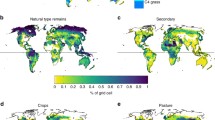Abstract
The effect of orography on the spatial variability of surface evaporation is studied numerically for two hill heights and two prescribed forms of surface resistance. A numerical model of the planetary boundary layer carrying scalars of temperature and specific humidity, and with a surface energy balance scheme, is employed. It is found that the difference in mean evaporation between model runs with hills and analogous runs for flat terrain may be explained primarily by an increase in surface area and adiabatic cooling at the hill surface.
Similar content being viewed by others
References
Claussen, M.: 1991, ‘Estimation of Areally-Averaged Surface Fluxes’, Boundary-Layer Meteorol. 54, 387-410.
Dolman, A. J. and Blyth, E. M.: 1997, ‘Patch Scale Aggregation of Heterogeneous Land Surface Cover for Mesoscale Meteorological Models’, J. Hydrol. 190, 252-268.
Dyer, A. J.: 1974, ‘A Review of Flux-Profile Relationships’, Boundary-Layer Meteorol. 7, 363-372.
Hewer, F. E. and Wood, N.: 1998, ‘The Effective Roughness Length for Scalar Transfer in Neutral Conditions over Hilly Terrain’, Quart. J. Roy. Meteorol. Soc., in press.
Paulson, C. A.: 1970, ‘Mathematical Representation of Wind Speed and Temperature Profiles in the Unstable Atmospheric Surface Layer’, J. Appl. Meteorol. 9, 857-861.
Raupach, M. R.: 1991, ‘Vegetation-Atmosphere Interaction in Homogeneous and Heterogeneous Terrain: Some Implications of Mixed-Layer Dynamics’, Vegetatio 91, 105-120.
Raupach, M. R., Weng, W. S., Carruthers, D. J., and Hunt, J. C. R.: 1992, ‘Temperature and Humidity Fields and Fluxes Over Low Hills’, Quart. J. Roy. Meteorol. Soc. 118, 191-225.
Verma, S. B.: 1989, ‘Aerodynamic Resistances to Transfers of Heat, Mass and Momentum’, IAHS Pub. 177, 13-20.
Wood, N. and Mason, P.: 1991, ‘The Influence of Static Stability on the Effective Roughness Lengths for Momentum and Heat Transfer’, Quart J. Roy. Meteorol. Soc. 117, 1025-1056.
Wood, N. and Mason, P.: 1993, ‘The Pressure Force Induced by Neutral, Turbulent Flow over Hills’, Quart. J. Roy. Meteorol. Soc. 119, 1233-1267.
Author information
Authors and Affiliations
Rights and permissions
About this article
Cite this article
Huntingford, C., Blyth, E.M., Wood, N. et al. The Effect of Orography on Evaporation. Boundary-Layer Meteorology 86, 487–504 (1998). https://doi.org/10.1023/A:1000795206459
Issue Date:
DOI: https://doi.org/10.1023/A:1000795206459




